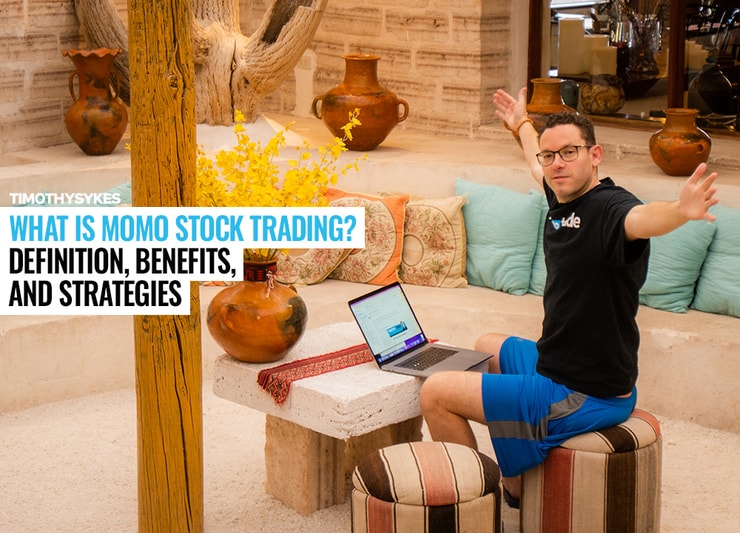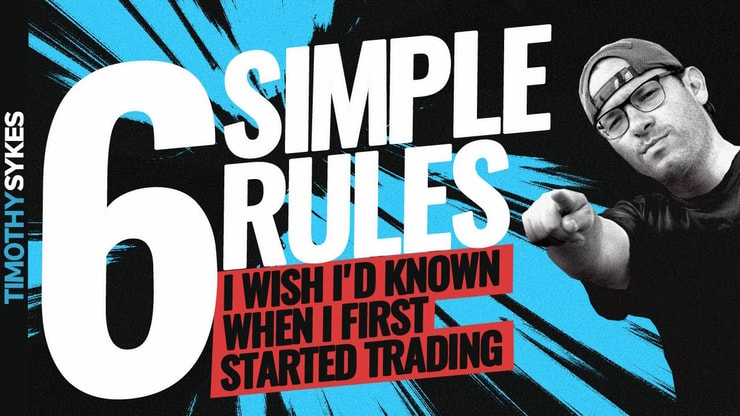In my two-plus decades trading penny stocks, I’ve seen several cycles of the market. One of the most powerful forces that drive these cycles is momentum.
Today, we’re going to delve into the world of MOMO trading, a strategy that seeks to harness the power of momentum. It isn’t as simple as it seems…
MOMO trading is like trying to navigate a fast-paced, ever-changing maze. You need to spot the trends, adapt quickly, and make your moves at the right time.
Ready to dive in? In this post, we’re going to cover everything you need to know about MOMO trading.
Table of Contents
- 1 What Does MOMO in MOMO Trading Stand For?
- 2 What Is Momentum Trading?
- 3 Benefits of Momentum Trading
- 4 Strategies for Momentum Trading
- 5 Technical Indicators in Momentum Trading
- 6 Momentum Trading in the Stock Market
- 7 Rules for a Long Trade
- 8 Rules for a Short Trade
- 9 Comparing FOMO and MOMO Trading
- 10 Key Takeaways
What Does MOMO in MOMO Trading Stand For?

2025 Millionaire Media, LLCMOMO is short for momentum.
In the world of day trading, momentum is everything. It’s the force that drives prices up and down. Now that members of the financial community, apps and site reviews, and brokers and their customers all understand its value, momentum levels can become a self-fulfilling prophecy.
When a stock has strong momentum, it means that its price is moving rapidly in a particular direction. This often results in the kind of performance and opportunity that MOMO traders are looking for!
What Is Momentum Trading?
Momentum trading is a strategy that aims to capitalize on the continuance of existing trends in the market. The idea is to find stocks that are already moving in a certain direction, and then jump on board to ride the momentum for as long as it lasts. It’s a strategy that requires quick decision-making, a keen eye for trends, and a solid understanding of market dynamics.
In the world of momentum trading, timing is everything. Enter too early, and you might find yourself stuck in a slow-moving stock. Enter too late, and you might catch the tail end of the trend, missing out on the bulk of the profits. But if you time it just right, you can catch the trend at its peak and ride it all the way to the bank.
It works for someone who isn’t content with the slow-moving investment services and instruments recommended by FINRA and Nasdaq analysts. If you’re one of the investors who relies on the advice of fund managers and banking bigwigs — if the biggest risk you take is to purchase ETFs — momentum trading probably isn’t for you. If you’re someone who questions the basis for traditional wisdom and doesn’t want to tie your trading life to the economy and the exchange, it might be just the ticket…
Watch this video to see how my millionaire student Roland Wolf used momentum trading to go up another level!
What Is a Momentum Trading Strategy?
A momentum trading strategy involves identifying stocks that are moving with strong momentum and placing trades that align with this momentum. It’s all about being in sync with the market and making your moves accordingly.
There are several ways to identify stocks with strong momentum. Some traders use technical indicators, such as the Moving Average Convergence Divergence (MACD) or the Relative Strength Index (RSI).
Learn how to trade with the MACD Indicator in 5 easy steps!
Others prefer to use price action, looking for patterns in share price movements that indicate a strong trend.
Once a stock with strong momentum is identified, the next step is to determine the right time to enter the trade. This could be when the stock breaks through a resistance level, when it bounces off a support level, or when it shows a certain pattern in its price action.
The final step is to manage the trade. This involves setting a stop loss to protect your downside, monitoring the trade as it progresses, and deciding when to exit the trade. This could be when the stock hits a certain price target, when it shows signs of reversing, or when it reaches a certain time limit.
Day trading is another approach that focuses on short-term trades based on small price movements. It requires a keen eye for detail, quick decision-making, and a solid understanding of market trends. If you’re interested in exploring this further, check out this comprehensive guide on Day Trading Strategy. Diversifying your trading strategies can help you navigate different market conditions and optimize your trading performance.
Benefits of Momentum Trading

2025 Millionaire Media, LLCMomentum trading comes with its own set of benefits. For one, it allows traders to capitalize on large price movements, potentially leading to significant profits. It also allows traders to make quick decisions, as trades are typically held for a short period of time.
Furthermore, momentum trading can be applied to a wide range of markets, including stocks, forex, and futures. This makes it a versatile strategy that can be used by traders of all types.
However, it’s important to remember that momentum trading also comes with its own set of risks. The same volatility that allows for large profits can also lead to large losses. Therefore, it’s crucial for traders to have a solid risk management strategy in place when engaging in momentum trading.
Benefits for Day Traders
For day traders, momentum trading can be a valuable strategy. It allows them to capitalize on short-term price movements and make quick profits. Since day traders typically close out their positions by the end of the trading day, the ability to identify and capitalize on short-term trends can be a significant advantage.
Furthermore, because momentum trading involves following trends, it can be less stressful than other trading strategies that require predicting future price movements. Instead of trying to predict where the market will go, momentum traders simply follow where the market is already going.
However, like all trading strategies, momentum trading is not without its risks. The high volatility that makes momentum trading attractive can also lead to significant losses if not managed properly. Therefore, it’s crucial for day traders to have a solid risk management strategy in place and to stick to it consistently.
More Breaking News
- MRM Stock Skyrockets: What’s Behind the 55% Surge?
- AST SpaceMobile Stock Skyrockets Following Strategic Developments and Analyst Upgrades
- Oppenheimer’s Price Target Raise Spurs Confidence in ATAI’s Growth Trajectory
- ALT5 Sigma Corporation’s Stocks Soar Amid Strategic Moves in Tech Expansion
Benefits for Experienced Traders
For experienced traders, momentum trading can be a powerful tool. It allows them to capitalize on large price movements and make substantial profits. Since experienced traders often have a deep understanding of market dynamics, they are well-equipped to navigate the volatility that comes with momentum trading.
Moreover, experienced traders often have the discipline and patience required to wait for the right trading opportunities. This can be a significant advantage in momentum trading, where timing is everything.
However, even experienced traders need to be mindful of the risks involved in momentum trading. The potential for large profits comes with the potential for large losses, so it’s crucial to have a robust risk management strategy in place.
Benefits for Beginner Traders
For beginner traders, momentum trading can be a great way to get started. It’s a straightforward strategy that can be easy to understand and implement. By focusing on stocks with strong momentum, beginner traders can limit their choices and avoid the overwhelm that can come with the vast number of stocks in the market.
Moreover, momentum trading can provide quick feedback, allowing beginner traders to learn and adjust their strategies quickly. This can be a valuable learning experience for those new to trading.
However, it’s important for beginner traders to understand the risks involved in momentum trading. The volatility that comes with momentum trading can lead to significant losses if not managed properly. Therefore, it’s crucial for beginners to start with a small trading account and to use a solid risk management strategy.
Strategies for Momentum Trading

2025 Millionaire Media, LLCThere are several strategies that traders can use when it comes to momentum trading.
Remember — these trading strategies are just the tip of the iceberg! Gap trading, for example, is a strategy that capitalizes on the price gaps that occur in the market due to various factors. It can provide a different perspective on market trends and price movements, which can be particularly useful when dealing with MOMO stocks.
To delve deeper into this strategy, check out this article on Gap Trading Strategy.
Price Crosses Strategy
The price crosses strategy involves identifying stocks where the price crosses a certain level, such as a moving average or a resistance level. When the price crosses this level with strong momentum, it can signal the start of a new trend. The idea is to enter the trade when the price cross occurs and ride the momentum for as long as it lasts.
Trailing Stops Strategy
The trailing stops strategy involves setting a stop loss that moves with the price of the stock. This allows you to lock in profits as the price moves in your favor, while also protecting you from significant losses if the price moves against you. The key is to set the trailing stop at a level that gives the stock enough room to fluctuate, but not so much that you risk losing a significant portion of your profits.
Market Leaders Strategy
The market leaders strategy involves identifying and trading stocks that are leading the market. These are stocks that are making significant price moves and showing strong momentum. The idea is to ride the momentum of these market leaders for as long as it lasts.
Technical Indicators in Momentum Trading
Technical indicators are tools that traders use to analyze price action and identify trends. They’re a crucial part of momentum trading.
You should know all of this, but remember to KEEP IT SIMPLE.
20-Period Exponential Moving Average (EMA) Five-Minute Chart
The 20-period exponential moving average (EMA) on a five-minute chart is a popular technical indicator for momentum trading. It helps identify short-term trends and can provide entry and exit signals for momentum trades. When the price is above the 20-period EMA, it indicates an uptrend. When the price is below the 20-period EMA, it indicates a downtrend.
Other Technical Indicators to Consider
There are many other technical indicators that can be useful for momentum trading. These include the Moving Average Convergence Divergence (MACD), the Relative Strength Index (RSI), and the Stochastic Oscillator. Each of these indicators provides different information about the market’s momentum and can help you make more informed trading decisions.
Combining Different Indicators for Maximum Profits
One strategy that many successful traders use is combining different indicators to maximize their profits. For example, you might use the 20-period EMA to identify the overall trend, the MACD to confirm the trend, and the RSI to identify overbought or oversold conditions. By using multiple indicators, you can get a more complete picture of the market’s momentum.
Choosing the Perfect Time Frame
Choosing the right time frame for your trades is crucial when it comes to momentum trading. You need to be able to spot trends early, jump in at the right time, and get out before the trend reverses. Some traders prefer to use a shorter time frame, like a five-minute chart, to catch short-term trends. Others prefer to use a longer time frame, like a daily chart, to catch longer-term trends.
Momentum Trading in the Stock Market

2025 Millionaire Media, LLCMomentum trading is a popular strategy in the stock market. It allows traders to capitalize on large price movements and make substantial profits. However, it’s important to remember that momentum trading also comes with its own set of risks. The same volatility that allows for large profits can also lead to large losses. Therefore, it’s crucial for traders to have a solid risk management strategy in place when engaging in momentum trading.
Finding these stocks is a skill that can be honed with practice and the right tools. However, it’s also crucial to understand other trading strategies that can complement your approach. For instance, reversal trading strategy can sometimes lead to price gaps as market sentiment changes.
To learn more about how this strategy works and how it can impact your trading decisions, take a look at this detailed article on Reversal Trading Strategy. The more strategies you’re familiar with, the better equipped you’ll be to make effective trading decisions.
Rules for a Long Trade
When it comes to making a long trade, there are a few rules you need to follow. First, you need to identify a stock that is moving with strong momentum. This means looking for stocks that are making significant price moves with high volume. You can use technical indicators like the Moving Average Convergence Divergence (MACD) or the Relative Strength Index (RSI) to help identify these stocks.
Second, you need to enter the trade at the right time. This means waiting for a confirmation of the trend before you enter the trade. You don’t want to jump in too early and get caught in a false breakout. Wait for the stock to break through a resistance level with strong volume before you enter the trade.
Third, you need to exit the trade before the trend reverses. This means setting a stop loss to protect your downside and watching the market closely for signs of a trend reversal. If the stock starts to move against you, don’t hesitate to exit the trade and cut your losses.
Rules for a Short Trade
When it comes to making a short trade, the rules are similar to making a long trade. You need to identify a stock that is moving with strong momentum, but in this case, the momentum is downward. Look for stocks that are making significant price drops with high volume.
Just like with a long trade, you need to enter the trade at the right time. Wait for the stock to break through a support level with strong volume before you enter the trade. And again, you need to exit the trade before the trend reverses. Set a stop loss to protect your downside and watch the market closely for signs of a trend reversal.
Comparing FOMO and MOMO Trading
FOMO (Fear Of Missing Out) trading and MOMO (Momentum) trading are two different approaches to the market. FOMO trading is driven by the fear of missing out on a potential profit, while MOMO trading is driven by the desire to ride the momentum of a trending stock.
FOMO trading can lead to impulsive decisions and reckless trading. Traders might jump into a trade without proper analysis or risk management, driven by the fear of missing out on potential profits. This can often lead to losses.
On the other hand, MOMO trading is more disciplined. MOMO traders wait for the right trading opportunities, they analyze the market carefully, and they manage their risk. They ride the momentum of a trending stock, but they also know when to exit the trade to protect their profits.
Key Takeaways

2025 Millionaire Media, LLCMOMO trading is a strategy that focuses on momentum. It’s about identifying stocks with strong momentum, entering the trade at the right time, and exiting the trade before the trend reverses. It’s a strategy that requires discipline, analysis, and risk management.
MOMO trading can be a profitable strategy for those who can master it. But it’s not for everyone. It requires quick decision-making, a keen eye for trends, and a high tolerance for risk. But for those who are willing to put in the time and effort to learn, it can be a rewarding strategy.
It isn’t a silver bullet for your trading plan — but MOMO trading is one of many topics you should learn as part of your trading education!
Trading isn’t rocket science. It’s a skill you build and work on like any other. Trading has changed my life, and I think this way of life should be open to more people…
I’ve built my Trading Challenge to pass on the things I had to learn for myself. It’s the kind of community that I wish I had when I was starting out.
We don’t accept everyone. If you’re up for the challenge — I want to hear from you.
Request to join the Trading Challenge here.
Trading is a battlefield. The more knowledge you have, the better prepared you’ll be.
Are you a MOMO trader? Let me know in the comments — I love hearing from my readers!










Leave a reply